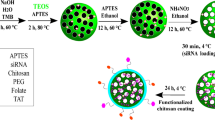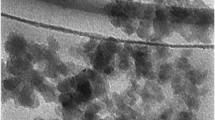ABSTRACT
Purpose
To prepare mesoporous silica-based delivery systems capable of simultaneous delivery of drugs and nucleic acids.
Methods
The surface of mesoporous silica nanoparticles (MSN) was modified with poly(ethylene glycol) (PEG) and poly(2-(dimethylamino)ethylmethacrylate) (PDMAEMA) or poly(2-(diethylamino)ethylmethacrylate) (PDEAEMA). The particles were then loaded with a lysosomotropic agent chloroquine (CQ) and complexed with plasmid DNA or siRNA. The ability of the synthesized particles to deliver combinations of CQ and nucleic acids was evaluated using luciferase plasmid DNA and siRNA targeting luciferase and GAPDH.
Results
The results show a slow partial MSN dissolution to form hollow silica nanoparticles in aqueous solution. The biological studies show that polycation-modified MSN are able to simultaneously deliver CQ with DNA and siRNA. The co-delivery of CQ and the nucleic acids leads to a significantly increased transfection and silencing activity of the complexes compared with MSN not loaded with CQ.
Conclusion
PEGylated MSN modified with polycations are promising delivery vectors for combination drug/nucleic acid therapies.












Similar content being viewed by others
Abbreviations
- APTES:
-
3-aminopropyltriethoxysilane
- CQ:
-
chloroquine
- CTAB:
-
N-cetyltrimethylammonium bromide
- DMEM:
-
Dulbecco’s modified Eagle’s medium
- GAPDH:
-
glyceraldehyde 3-phosphate dehydrogenase
- MPA:
-
3-mercaptopropionic acid
- MPTMS:
-
3-mercaptopropyltrimethoxysilane
- MSN:
-
mesoporous silica nanoparticles
- PDEAEMA:
-
poly(2-(diethylamino)ethylmethacrylate)
- PEG:
-
poly(ethylene glycol)
- PEI:
-
polyethyleneimine
- PDMAEMA:
-
poly(2-(dimethylamino)ethylmethacrylate)
- PMSN:
-
PEG-coated MSN
- TEOS:
-
tetraethylorthosilicate
REFERENCES
Jia J, Zhu F, Ma X, Cao ZW, Li YX, Chen YZ. Mechanisms of drug combinations: interaction and network perspectives. Nat Rev Drug Discov. 2009;8:111–28.
Yadav S, van Vlerken LE, Little SR, Amiji MM. Evaluations of combination MDR-1 gene silencing and paclitaxel administration in biodegradable polymeric nanoparticle formulations to overcome multidrug resistance in cancer cells. Cancer Chemother Pharmacol. 2009;63:711–22.
Quist SR, Wang-Gohrke S, Kohler T, Kreienberg R, Runnebaum IB. Cooperative effect of adenoviral p53 gene therapy and standard chemotherapy in ovarian cancer cells independent of the endogenous p53 status. Cancer Gene Ther. 2004;11:547–54.
Griffith TS, Stokes B, Kucaba TA, Earel JK, VanOosten RL, Brincks EL, et al. TRAIL gene therapy: from preclinical development to clinical application. Curr Gene Ther. 2009;9:9–19.
Viitala R, Jokinen M, Tuusa S, Rosenholm JB, Jalonen H. Adjustably bioresorbable sol-gel derived SiO2 matrices for release of large biologically active molecules. J Sol Gel Sci Technol. 2005;36:147–56.
Lebold T, Jung C, Michaelis J, Brauchle C. Nanostructured silica materials as drug-delivery systems for doxorubicin: single molecule and cellular studies. Nano Lett. 2009;9:2877–83.
Liong M, Lu J, Kovochich M, Xia T, Ruehm SG, Nel AE, et al. Multifunctional inorganic nanoparticles for imaging, targeting, and drug delivery. ACS Nano. 2008;2:889–96.
Vivero-Escoto JL, Slowing II, Wu CW, Lin VS. Photoinduced intracellular controlled release drug delivery in human cells by gold-capped mesoporous silica nanosphere. J Am Chem Soc. 2009;131:3462–3.
Lu J, Liong M, Zink JI, Tamanoi F. Mesoporous silica nanoparticles as a delivery system for hydrophobic anticancer drugs. Small. 2007;3:1341–6.
Xia T, Kovochich M, Liong M, Meng H, Kabehie S, George S, et al. Polyethyleneimine coating enhances the cellular uptake of mesoporous silica nanoparticles and allows safe delivery of siRNA and DNA constructs. ACS Nano. 2009;3:3273–86.
Radu DR, Lai C-Y, Jeftinija K, Rowe EW, Jeftinija S, Lin VS-Y. A polyamidoamine dendrimer-capped mesoporous silica nanosphere-based gene trasfection reagent. J Am Chem Soc. 2004;126:13216–7.
Chen AM, Zhang M, Wei D, Stueber D, Taratula O, Minko T, et al. Co-delivery of doxorubicin and Bcl-2 siRNA by mesoporous silica nanoparticles enhances the efficacy of chemotherapy in multidrug-resistant cancer cells. Small. 2009;5:2673–7.
Lai C-Y, Trewyn BG, Jeftinija DM, Jeftinija K, Xu S, Jeftinija S, et al. A mesoporous silica nanosphere-based carrier system with chemically removable cds nanoparticle caps for stimuli-responsive controlled release of neurotransmitters and drug molecules. J Am Chem Soc. 2003;125:4451–9.
You Y-Z, Kalebaila KK, Brock SL, Oupický D. Temperature-controlled uptake and release in PNIPAM-modified porous silica nanoparticles. Chem Mater. 2008;20:3354–9.
Radu DR, Lai C-Y, Huang J, Shu X, and Lin VS-Y. Fine-tuning the degree of organic functionalization of mesoporous silica nanosphere materials via an interfacially designed co-condensation method. Chemical Communications 2005;1264–1266.
Rosenholm JM, Linden M. Wet-chemical analysis of surface concentration of accessible groups on different amino-functionalized mesoporous SBA-15 silicas. Chem Mater. 2007;19:5023–34.
Coradin T, Eglin D, Livage J. The silicomolybdic acid spectrophotometric method and its application to silicate/biopolymer interaction studies. Spectrosc Int J. 2004;18:567–76.
Galarneau A, Nader M, Guenneau F, Di Renzo F, Gedeon A. Understanding the stability in water of mesoporous SBA-15 and MCM-41. J Phys Chem C. 2007;111:8268–77.
Finnie KS, Waller DJ, Perret FL, Krause-Heuer AM, Lin HQ, Hanna JV, et al. Biodegradability of sol-gel silica microparticles for drug delivery. J Sol-Gel Sci Technol. 2009;49:12–8.
Lin Y-S, Haynes CL. Impacts of mesoporous silica nanoparticle size, pore ordering, and pore integrity on hemolytic activity. J Am Chem Soc. 2010;132:4834–42.
Jugdaohsingh R, Reffitt DM, Oldham C, Day JP, Fifield LK, Thompson RPH, et al. Oligomeric but not monomeric silica prevents aluminum absorption in humans. Am J Clin Nutr. 2000;71:944–9.
Klause M, Rothhaar U, Bicker M, Ohling W. Dissolution of thin SiO2-coatings - characterization and evaluation. J Non-Cryst Solids. 2010;356:141–6.
Abou-El-Sherbini KS, Pape C, Rienetz O, Schiel D, Stosch R, Weidler PG, et al. Stabilization of n-aminopropyl silica gel against hydrolysis by blocking silanol groups with TiO2 or ZrO2. J Sol-Gel Sci Technol. 2010;53:587–97.
You Y-Z, Kalebaila KK, Brock SL, Oupicky D. Temperature-controlled uptake and release in PNIPAM-modified porous silica nanoparticles. Chem Mater. 2008;20:3354–9.
Yang S, Coles DJ, Esposito A, Mitchell DJ, Toth I, Minchin RF. Cellular uptake of self-assembled cationic peptide-DNA complexes: multifunctional role of the enhancer chloroquine. J Control Rel. 2009;135:159–65.
Gabrielson NP, Pack DW. Efficient polyethylenimine-mediated gene delivery proceeds via a caveolar pathway in HeLa cells. J Control Release. 2009;136:54–61.
Cheng J, Zeidan R, Mishra S, Liu A, Pun SH, Kulkarni RP, et al. Structure-function correlation of chloroquine and analogues as transgene expression enhancers in nonviral gene delivery. J Med Chem. 2006;49:6522–31.
Oupicky D, Carlisle RC, Seymour LW. Triggered intracellular activation of disulfide crosslinked polyelectrolyte gene delivery complexes with extended systemic circulation in vivo. Gene Ther. 2001;8:713–24.
Luten J, van Nostrum CF, De Smedt SC, Hennink WE. Biodegradable polymers as non-viral carriers for plasmid DNA delivery. J Control Rel. 2008;126:97–110.
de Wolf HK, de Raad M, Snel C, van Steenbergen MJ, Fens MH, Storm G, et al. Biodegradable poly(2-dimethylamino ethylamino)phosphazene for in vivo gene delivery to tumor cells. Effect of polymer molecular weight. Pharm Res. 2007;24:1572–80.
Blacklock J, You YZ, Zhou QH, Mao G, Oupicky D. Gene delivery in vitro and in vivo from bioreducible multilayered polyelectrolyte films of plasmid DNA. Biomaterials. 2009;30:939–50.
Hunter AC. Molecular hurdles in polyfectin design and mechanistic background to polycation induced cytotoxicity. Adv Drug Deliv Rev. 2006;58:1523–31.
Fischer D, Li Y, Ahlemeyer B, Krieglstein J, Kissel T. In vitro cytotoxicity testing of polycations: influence of polymer structure on cell viability and hemolysis. Biomaterials. 2003;24:1121–31.
Malik N, Wiwattanapatapee R, Klopsch R, Lorenz K, Frey H, Weener JW, et al. Dendrimers: relationship between structure and biocompatibility in vitro, and preliminary studies on the biodistribution of 125I-labelled polyamidoamine dendrimers in vivo. J Control Release. 2000;65:133–48.
Fischer D, Bieber T, Li Y, Elsasser HP, Kissel T. A novel non-viral vector for DNA delivery based on low molecular weight, branched polyethylenimine: effect of molecular weight on transfection efficiency and cytotoxicity. Pharm Res. 1999;16:1273–9.
Slita AV, Kasyanenko NA, Nazarova OV, Gavrilova II, Eropkina EM, Sirotkin AK, et al. DNA-polycation complexes: effect of polycation structure on physico-chemical and biological properties. J Biotechnol. 2007;127:679–93.
ACKNOWLEDGMENTS
This work was supported by NIH Grant EB0043588 from the National Institute of Biomedical Imaging and Bioengineering.
Author information
Authors and Affiliations
Corresponding author
Electronic supplementary material
Below is the link to the electronic supplementary material.
ESM. 1
(DOC 1614 kb)
Rights and permissions
About this article
Cite this article
Bhattarai, S.R., Muthuswamy, E., Wani, A. et al. Enhanced Gene and siRNA Delivery by Polycation-Modified Mesoporous Silica Nanoparticles Loaded with Chloroquine. Pharm Res 27, 2556–2568 (2010). https://doi.org/10.1007/s11095-010-0245-0
Received:
Accepted:
Published:
Issue Date:
DOI: https://doi.org/10.1007/s11095-010-0245-0




